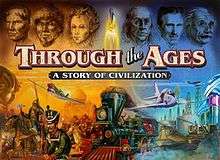Through the Ages: A Story of Civilization

Through the Ages: A Story of Civilization is a board game for 2–4 players designed by Vlaada Chvatil and published by Czech Board Games in 2006. Its theme is the development of human civilization and the players determine the progress of their own civilization in different fields including culture, government, leadership, religion and science.[1] The game has won multiple awards including the International Gamer’s Award in 2007 and Game of the Year in Poland in 2010, where it was published as Cywilizacja: Poprzez Wieki.[2]
The game is about building a civilization, including urban buildings, governments, population, resource productions, military etc. By drawing and buying cards the players take their civilizations through 4 ages - beginning with classical antiquity and ending in the Modern Age. The game has spent over 5 years ranked in the top five board games at Board Game Geek.
In 2015 an updated version, entitled Through the Ages: A New Story of Civilization, was published with updated artwork and with a number of rule tweaks.
Game Description
Through the Ages is a civilization building game. The goal is to develop your civilization, not to destroy other ones. Military strength is just one aspect of your nation, as well as population, production or science. It is up to you which aspect you will concentrate on, more or less, but you should not underestimate any of them while building your civilization. Victory is achieved by the player whose nation produces the most culture during the game. However, there are many ways to produce culture: through religion, literature or drama, by building wonders, by utilizing cultural persons etc. Considerable amount of culture can be gained even via wars or aggression.
References
- ↑ Brian Mayer, Christopher Harris (2009), Libraries got game, p. 54, 123, ISBN 978-0-8389-1009-2
- ↑ David Welsh (April 28, 2010), Through the Ages Wins Polish Game Award, Game Salute
External links
- Through the Ages: A Story of Civilization at BoardGameGeek
- Through the Ages: A New Story of Civilization at BoardGameGeek
- Czech Board Games
- Online version